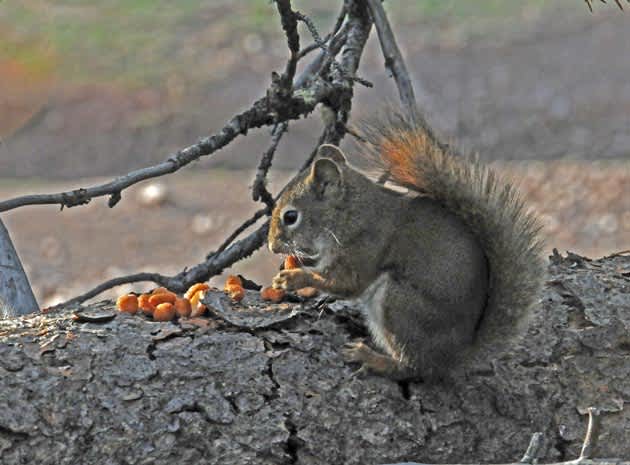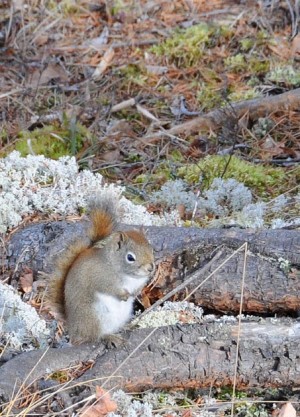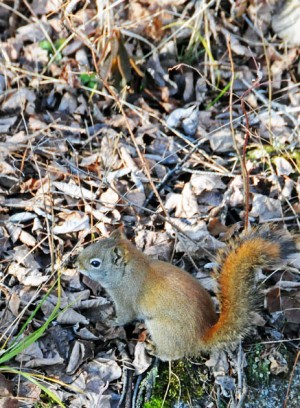Red Squirrels: Profile of a Feisty Small Game Species
Patrick Durkin 04.11.13

While refilling our bird feeders last week, I noticed a golf-ball sized hole in the mesh bag holding the suet, which is actually about 10 pounds of fat I carved from a deer’s rump in late November.
I’ve never known nuthatches, chickadees, or woodpeckers to punch holes in a suet bag. Why would they bother? It’s mesh. I studied the bag, but its tattered hole held no clues. All I saw were gouges, scratches and needle holes in the fat where beaks once probed.
The mystery ended the next morning as I watched the feeders from our kitchen window while washing breakfast bowls. Something moved atop the suet bag. A small squirrel with a copper-orange back was gnawing on the fat, its head poking through the hole in the mesh.
Wow. A red squirrel. Or as some folks call it, a pine squirrel. There’s no mistaking one. Besides its wee frame and copper backside, a red squirrel’s dark eyes are uniquely fringed by a thin circle of white fur.
But they’re uncommon around our home in central Wisconsin. In 20 years of feeding birds here, we’ve seen two red squirrels. In contrast, I’ve seen plenty of red squirrels the past 40-plus years when hunting the coniferous forests of the upper Great Lakes and Rocky Mountains.

Even so, I’d never before seen a red squirrel eating fat and meat scraps. And he wasn’t just swiping samples like freeloaders circling a grocer’s cheese plate. No, it was digging and clawing into the frozen fat, hopping to the branch above, licking its paws clean, and then diving back into its chew-hole for more.
I sought confirmation by calling Professor Scott Craven, the University of Wisconsin-Madison’s venerable answer-man for all things mammal. Craven assured me I wasn’t seeing things. He said all tree squirrels eat some meat, such as when stumbling across big insects, bird eggs, nestlings, or the babies of small mammals.
But red squirrels eat more meat than fox or gray squirrels. They’re also the most aggressive of the three, despite being the smallest, measuring 11 to 13 inches nose to tail-tip. If a gray or fox squirrel is on a bird feeder when a red squirrel arrives, the mighty mite runs them off.
Even so, don’t believe that wives’ tale about red squirrels castrating gray or fox squirrel males in territorial spats. The bigger squirrels can backhand little Napoleon if pushed too far.
Craven also confirmed it’s unusual to see red squirrels in my area, but not rare. After all, Wisconsin might be the southern edge of the red squirrel’s range, but they’re found from Alaska to Labrador, and from river bottoms to Rocky Mountain peaks.
In the Great Lakes region, they’re most abundant in the northern forests, especially those dominated by pine, spruce and fir. They also frequently inhabit the river corridors and long stretches of remote shorelines on the Great Lakes themselves.
Among the red squirrel’s charms is its bold, curious nature. They often crash our Idaho elk camp to filch peanuts a few feet from where we sit. And if we return to camp and can’t find a snap-on lid for a favorite cup, we follow the log where we last laid it. Experience teaches us that chewed lids wait wherever red squirrels lose interest and drop them.
They aren’t so patient or tolerant when we invade their workspace, however. They start chattering and stamping their feet the second they see us, never believing our intentions are good. And no matter how quiet and respectful our pleas for peace, they slur our wives and curse our names until we move on.
Sheesh. You’d understand their attitude if you had refused them handouts during snack breaks, or raided their middens of green cones cut from Douglas firs and lodgepole pines. But eventually you realize it’s nothing personal. Red squirrels heckle everyone.
Still, you wouldn’t be human if you didn’t occasionally give one the stink-eye and wonder: Could I hit that little jerk with my arrow? If so, how would he taste? Could I sell his pelt and tail?

I’ve eaten plenty of gray squirrels and fox squirrels, but never a red squirrel, though they probably hold as much meat as chicken wings. And their tails and hides aren’t worthless. In fact, Sheldon’s Inc. in Antigo, Wisconsin, makers of Mepps fishing lures, pays 8 cents each for red squirrel tail if hairs at the base measure an inch or more (tails from gray squirrels and fox squirrels fetch 16 to 20 cents each).
And believe it or not, some Northwoods and Canadian trappers collect their pelts, which fetch about $1.50 each but get as much as $2.75 some years at fur auctions. As one trapper-friend notes, they’re about the size of weasels–or ermine–so there’s precedence.
Their end use? Red squirrel pelts line the interiors of some leather jackets and London Fog raincoats. They can also be fashioned into cravats for gentlemen. In fact, red squirrels were hunted so commonly in ancient Finland that their pelts were used as currency before Finns discovered coins.
But for the most part, red squirrels face few threats from hunters and trappers; at least those with two legs. Owls, hawks, and kestrels prey on them, as do most four-legged predators, especially pine martens. As Craven says, what fishers are to porcupines, martens are to red squirrels.
States like Wisconsin have few martens, of course, but I’ve seen them hunting during deer hunts in northeastern Minnesota and elk in southeastern Idaho. But I certainly see no martens around Waupaca. We do see plenty of roaming cats, however. But judging by the red squirrel’s alert, energetic nature, I doubt they’re easy prey.
That is, unless their heads are shoved too deeply into suet bags.

